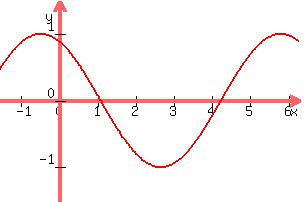Question 614852: the smallest positive zero of the function y=cosk(x+1/2) occurs at x=1/2. find k if k>0
Answer by KMST(5328)   (Show Source): (Show Source):
You can put this solution on YOUR website! The graph of the function y=cos(x) looks like this:

It has a period of  , so it repeats every , so it repeats every  , and becomes zero again and again at , and becomes zero again and again at  intervals. intervals.
The graph of the function y=cos(x+1/2) looks similar but shifted to the left.  , and the graph looks like this: , and the graph looks like this:

The period is still  , so it also repeats every , so it also repeats every  , and it also becomes zero again and again at , and it also becomes zero again and again at  intervals. intervals.
If there is a factor (k) as part of the angle, as in  , the period changes. With a larger k, we cover an angle range of , the period changes. With a larger k, we cover an angle range of  faster and the period gets smaller. For example, y=cos(2x) looks like this: faster and the period gets smaller. For example, y=cos(2x) looks like this:

with a period of  and zeros at and zeros at  intervals. intervals.
In general the period would be  and the zeros would occur at and the zeros would occur at  intervals. intervals.
So if  , the zeros will happen at intervals of , the zeros will happen at intervals of  and along with a zero at x=1/2 there would be a smaller positive zero, between x=0 and x=1/2. and along with a zero at x=1/2 there would be a smaller positive zero, between x=0 and x=1/2.
The positive k solutions should be 
The most obvious solution is  . .
The problem says the smallest positive zero happens for  , and we know that , and we know that  , so maybe , so maybe
 --> --> 
Then, for x=1/2,  , and , and  , ,
but for smaller positive x values,  , the angle , the angle  is positive but smaller than is positive but smaller than  , and its cosine is positive, never zero. , and its cosine is positive, never zero.
Then x=1/2 is the smallest positive zero.
Trial and error could show you that  is also a solution, but we can prove that it is the only other solution. is also a solution, but we can prove that it is the only other solution.
 --> -->  for any integer n, and since it must be for any integer n, and since it must be
 , then the only solutions are , then the only solutions are
 and and  . .
|
|
|